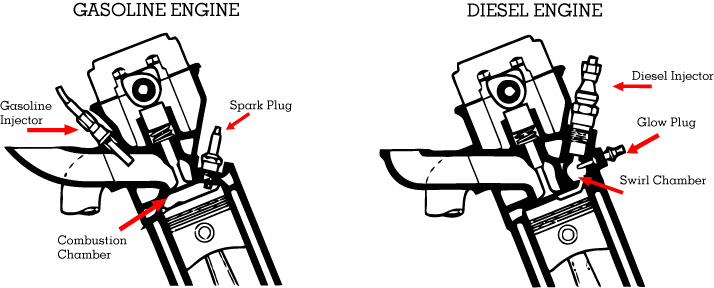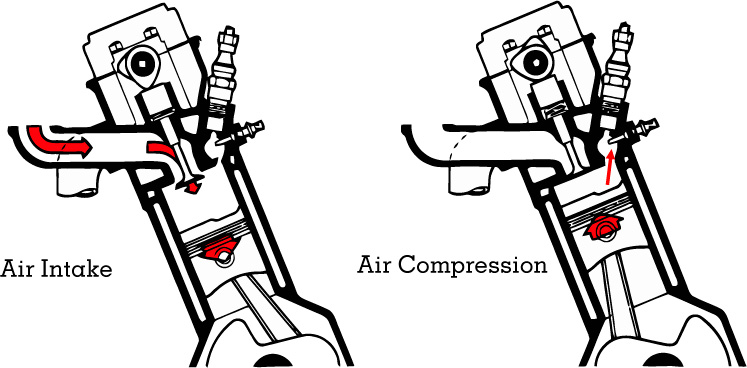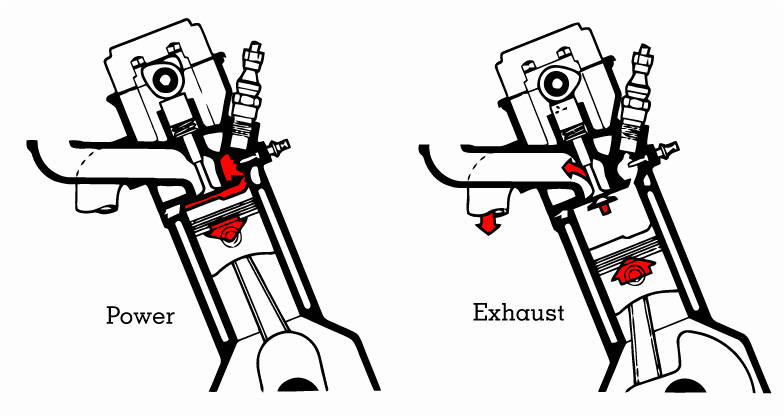Gasoline engines – Diesel engines: Differences and Similarities
[ezcol_1half]Internal combustion engine[/ezcol_1half] [ezcol_1half_end]Internal combustion engine[/ezcol_1half_end]
[ezcol_1half]Four stroke cycle[/ezcol_1half] [ezcol_1half_end]Four stroke cycle[/ezcol_1half_end]
[ezcol_1half]In-line cylinder arrangement[/ezcol_1half] [ezcol_1half_end]In-line cylinder arrangement[/ezcol_1half_end]
[ezcol_1half]Compression ratio approx. 8.0:1[/ezcol_1half] [ezcol_1half_end]Compression ratio approx. 23.0:1[/ezcol_1half_end]
[ezcol_1half]Thermal efficiency about 25%[/ezcol_1half] [ezcol_1half_end]Thermal efficiency about 36%[/ezcol_1half_end]
The thermal (heat) efficiency of an engine is the amount of fuel energy capable of being converted into usable power
[ezcol_1half]Point of ignition is timed by spark[/ezcol_1half] [ezcol_1half_end]Point of ignition is timed by fuel injection[/ezcol_1half_end]
[ezcol_1half]Spark ignition (air and gasoline ignited by spark)[/ezcol_1half] [ezcol_1half_end]Compression-ignition (Fuel is ignited by hot air)[/ezcol_1half_end]
[ezcol_1half]Ignition distributor distributes spark[/ezcol_1half] [ezcol_1half_end]Fuel injection pump distributes fuel[/ezcol_1half_end]
[ezcol_1half]On the intake stroke the intake valve opens and the piston begins its movement
downward in the cylinder.[/ezcol_1half] [ezcol_1half_end]On the compression stroke the intake valve closes and the piston begins its movement
upward in the cylinder.[/ezcol_1half_end]
[ezcol_1half]Air without fuel is taken into the cylinder.[/ezcol_1half] [ezcol_1half_end]The “air only” charge present in the cylinder is compressed until it becomes very hot (superheated to about 1000° F).
Air without fuel is taken into the cylinder.
Fuel is injected into the swirl chamber near the end of the compression stroke and is
ignited by the hot air.[/ezcol_1half_end]
[ezcol_1half]On the power stroke – the fuel rapidly burning from the swirl chamber to the cylinder causes high pressure to be exerted on the piston thrusting it downward in the cylinder and providing power for the engine.[/ezcol_1half] [ezcol_1half_end]On the exhaust stroke the exhaust valve opens and the piston begins its movement upward in the cylinder. The gases from the fuel burned during the power stroke are pushed out the exhaust port.[/ezcol_1half_end]



